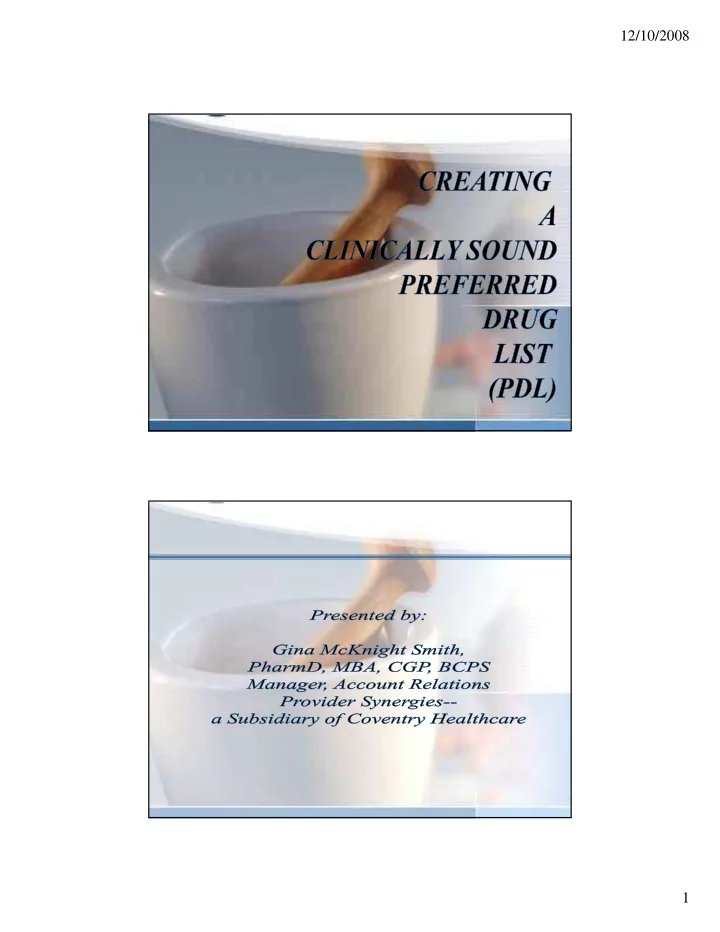

12/10/2008 1
12/10/2008 • Provide introduction/overview of the history of the Preferred Drug List (PDL) • Identify various clinical strategies for creating a PDL • Explain the interrelationship between a PDL and the rebate contracting process • Define the tools needed to manage and measure PDL impact • Describe new PDL opportunities including Specialty PDL 2004 - $1.9 trillion 2006 – $2.1 trillion Anticipate growth rate of about 2% between 2007 and 2017 By 2017 - $4.3 trillion 2
12/10/2008 2005 – 5.8% of National Healthcare Expenditures 2006 – 8.5% of NHE 2007 – 6.7% of NHE 2008 to 2017 projections – 6.7% of NHE Increased utilization Higher Costs of New Medications Escalating Prices 3
12/10/2008 . National Health Expenditures data for prescription drugs from CMS, Office of the Actuary, National Health Statistics Group at http://www.cms.gov/statistics/nhe/historical/ PDLs have been in existence since 2001 Prior authorization programs have been around prior to 2001 PDL = Formulary Pharmacoeconomic studies of PDLs – reliability? 4
12/10/2008 Follow rationale of current treatment guidelines Adhere to FDA approved labeling Offer comparative analysis of drugs with similar pharmacology Observe a consistent clinical review prior to an economic analysis Use of up-to-date therapeutic class reviews (TCRs) TCRs have comprehensive summary of product and clinical information on each drug within a therapeutic class Format of TCRs facilitates easy drug comparisons Charts are used for easy readability, comprehension and comparisons when appropriate Systematic method of evaluating the clinical literature in an evidence-based approach 5
12/10/2008 Each TCR identifies the search strategy and any pertinent exclusion criteria specific to a given therapeutic class Class A (randomized, controlled trials) data is the preferred standard. Updating and editing is ongoing and includes a QA process Up to date (within last six months) overview of comparative evaluation of the evidence Annual highlights of new information added since previous review builds efficiency Economic analysis begins after complete clinical review Drugs are more similar than different Cost differences are the next logical step to examine – but how do we get to the net cost? 6
12/10/2008 An after purchase reimbursement by a drug manufacturer to the payer (e.g. Medicaid) Types of rebates: Federal Supplemental (State solicited) • Medicaid Drug Rebate Program was created by OBRA ’ 90 (Omnibus Budget Reconciliation Act of 1990) • CMS enters agreement with manufacturers to provide this rebate for drug products paid for by Medicaid 7
12/10/2008 • Average Manufacturer Price (AMP) • Best Price (BP) • Unit Rebate Amount (URA) • Innovator Drugs (Single Source Brands) • Larger of 15.1% of AMP/unit or the difference between AMP and BP/unit • Non Innovator Drugs (Generics and Multi-Source Brands) • 11% of AMP/unit 8
12/10/2008 EXAMPLE #1 EXAMPLE #2 • AMP = $2 per unit • AMP = $2 per unit • BP = $1 per unit • BP = $1.80 per unit • Best Price Discount • Best Price Discount = $1 per unit or 50% = $0.20 per unit or of AMP 10% of AMP • Flat Rebate = 15.1% • Flat Rebate = 15.1% • Additional Rebate = • Total Rebate = 15.1% 34.9% • Total Rebate = 50% PDL Based Rebates Rebate offered after product receives preferred status Variations in offerings may be based on positioning 9
12/10/2008 Market share rebates depend on: number of drugs within a class utilization levels of a particular drug ability to impact market share independent of DTC advertising, sales force and other marketing initiatives • GNUP = Guaranteed Net Unit Price • WAC = Wholesale Acquisition Cost • Federal Rebate • All of these are used to calculate the supplemental rebate GNUP = WAC – Fed Rebate – Supp Rebate 10
12/10/2008 Manufacturers agree to pay supplemental rebates to State Medicaid Programs Manufacturers agree to a price guarantee for a specified period of time • Prior Authorization (PA) – its clinical purpose • Implementation of PA 1. Automatic approval upon prescriber request 2. Trial of preferred agent(s) 3. Additional Clinical Criteria • Documented contraindications • Documented allergic reactions 11
12/10/2008 Cost Containment Rebate Maximization Concentrated Purchasing Power Through Multi-State Pooling Arrangements (e.g. TOP$, NMPI, SXC) • First Health 2004 – NMPI (National Medicaid Pooling Initiative) • Provider Synergies 2005 - TOP$ (The Optimal PDL $olution) • SSDC 2006 (Sovereign States Drug Consortium) 12
12/10/2008 • Improved adherence to evidence based treatment standards • Savings – SHOW ME the MONEY! - Reduced Net Drug Costs - Diminished drug spend increases - Directed market share shifts - Increased generic utilization rates 13
12/10/2008 • PDLs are a one size fit all approach • PDLs are too restrictive and are really formularies • PDLs interfere with doctor patient relationship • PDLs in Medicaid settings impact prescribing in both Medicaid and non- Medicaid populations • PDLs actually increase costs related to hospitalizations and physician visits • Tiered PDL • Based on Therapeutic Class • Based on Indications • Based on Route of Administration • Specialty PDL 14
12/10/2008 Specialty drugs are usually • Expensive • Typically administered by injection or infusion • Target chronic or life-threatening diseases • Need special handling • Have complex reimbursement & distribution systems 15
12/10/2008 • PDLs can save money and curtail an increasing trend of rising drug spend. • A clinically well designed PDL is congruent with current treatment guidelines and encourage appropriate, rational and evidence based drug use. • Stakeholder buy-in is important when implementing and managing a clinically sound PDL. A clinically sound PDL should offer access to the safest, most effective drugs that will produce the desired goals of therapy at the most reasonable cost to the payer and the healthcare system. 16
12/10/2008 17
Recommend
More recommend